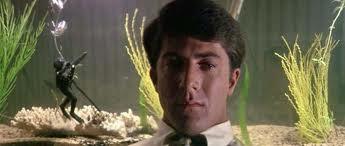 The Graduate (1967)
The Graduate (1967)Note to readers: In homage to director Mike Nichol’s recent passing at age 83, I am re-running one of my earlier blog post regarding his fabulous comedy-drama The Graduate.
Never had poster art so succinctly summarized the essence of a film. The raised leg forming either an arch or a bridge to unimagined pleasures; the low camera angle reflecting the situation at hand; the shot of a smirking, incredulous college graduate named Benjamin; the rhetorical and self-fulfilling query uttered by him (“Mrs. Robinson, you’re trying to seduce me. Aren’t you?”); and, of course, the half-mocking, self-implicating laughter by the cynical Mrs. Robinson.
Then, there is the music:
“Hello darkness, my old friend
I’ve come to talk with you again”
The first lines of director Mike Nichols’ screen adaptation of Charles Webb’s novel The Graduate come from “The Sounds of Silence,” written and performed by singer-songwriter Paul Simon and his partner Art Garfunkel. Contrary to accepted wisdom, the song was unrelated to Nichols’ iconic film, but only became part of the finished soundtrack as an afterthought.
At the time, The Graduate seized upon the prevailing mood of the era, which reflected the angst, the awkwardness, and the uncertainty of modern life, as well as the feelings of impending doom that the Vietnam War (and other crises) would soon bring to the fore. What Nichols brought to the material (an opening salvo in the so-called Hollywood “New Wave” of contemporary productions) was a biting wit and satiric edginess that captured the true essence of the turbulent sixties as few flicks of the era did.
Not to say there weren’t other, equally absorbing glimpses into sixties pop culture (Bonnie and Clyde and In the Heat of the Night among the better ones); but this film, which made stars of its leads — and a household word out of Simon and Garfunkel – was the hands-down favorite.
The sexual revolution is about to kick into high gear when Benjamin Braddock (a perpetually befuddled Dustin Hoffman, in his first major screen role), the clueless graduate of the title, comes home after four years of undergraduate studies in the East. Benjamin has no idea what to do with his life; his rich, upper-class parents (William Daniels and Elizabeth Wilson) provide little guidance, as do their unhelpful neighbors:
“I just want to say one word to you,” the kindly Mr. McGuire advises him. “Just one word. Are you listening? Plastics.”

Unable to face up to the challenge, Benjamin isolates himself in his room, brooding and reflecting upon his worthlessness. Into his dreary world walks Mrs. Robinson (a supremely self-possessed Anne Bancroft, who was only a few years older than Hoffman), the alcoholic wife of his father’s best friend and law partner (delightfully underplayed by a laid-back Murray Hamilton).
Mrs. Robinson initiates the young fool into the pleasures of the flesh, which boosts the ungainly Benjamin’s confidence level to no end. A hilarious hotel rendezvous notwithstanding, wherein the utterly bewildered Benjamin almost loses what’s left of his bearings (and his sanity), all goes well with the affair. That is, until he is introduced to Mrs. Robinson’s strikingly beautiful daughter, Elaine (angelic looking Katharine Ross). When Mrs. Robinson hears of the couple’s budding romance, she decides to take matters into her own hands, to disastrous but ultimately comic effect.
Many of the film’s most memorable moments, including Dustin’s head-banging episode at the hotel room, were spur-of-the-moment inspirations, as recounted in Mark Harris’ book Pictures at a Revolution. Besides the other Simon and Garfunkel hits scattered throughout the story (“Mrs. Robinson,” “Scarborough Fair/Canticle,” and “April Come She Will”), the remaining music was supplied by jazz artist Dave Grusin.
Calder Willingham and Buck Henry wrote the riotous screenplay, with Buck playing it straight as the deadpan Room Clerk. There are many priceless vignettes by an army of featured contract players, including (try to spot them) Alice Ghostley, Marion Lorne, Norman Fell (“I don’t think we’ll have any more of this agitation. Will we, Mr. Braddock?”), Mike Farrell, Richard Dreyfuss, Elaine May (who partnered with Nichols onstage in the fifties and sixties), Jonathan Hole, Noam Pitlik, and Kevin Tighe.
Even approaching “middle age,” the film is still as fresh, funny and sharp as it was back in 1967. Our favorite scenes are Benjamin’s disruption of Elaine’s wedding ( with Benjamin rattling the doors of the church at back and on high, and shouting “Elaine! Elaine!”), and the iconic last shot of the two of them in the back of the bus with a look of “Now what?” on their faces. This one scores a perfect 10 in my book.
Copyright © 2014 by Josmar F. Lopes

